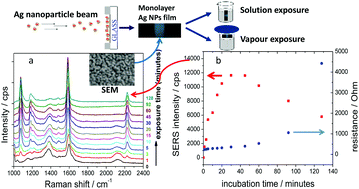A SERS and electrical sensor from gas-phase generated Ag nanoparticles self-assembled on planar substrates†
Abstract
Optical excitation of coupled plasmonic nanoparticles supports intense localized electromagnetic “hot-spots” which enable a variety of surface enhanced spectroscopies with the best known example being surface enhanced Raman scattering (SERS), currently of great interest for sensing applications. In this study, we present a novel SERS and electrical dual transduction chemical sensor based on gas-phase generated, negatively charged, silver nanoparticles self-assembled on glass slide forming a close-packed plasmonic monolayer thin-film that supports both SERS and electrical sensing. We demonstrate broad tunability of the localized surface plasmon resonance (LSPR) of the close-packed plasmonic nanoparticle monolayer thin-film sensors through control of the nanoparticle (NP) deposition time which directly influences the plasmonic coupling between neghibouring NPs. This broad tunability supports strong SERS activity from visible to near infrared (NIR) excitation wavelengths. We performed SERS and electrical measurements of a non-resonant molecule 4-mercaptobenzonitrile (4-MBN) as a sample Raman reporter molecule to determine the SERS enhancement factor of our SERS substrate. We measured an average SERS enhancement factor of 107 from our close-packed plasmonic nanoparticle monolayer thin-film sensor. Films which were grown below or above one nanoparticle monolayer both exhibited significantly lower SERS performance in one or more of SERS enhancement factor (EF), uniformity or repeatability. Our close-packed plasmonic nanoparticle monolayer thin-film sensors are highly uniform from point-to-point across the entire substrate and showed good reproducibility from batch-to-batch. These qualities are highly desirable for quantifiable detection of chemical and biological molecules. As an example application, this type of substrates provides an affordable and reliable sensing and identification capability for combatting new and emerging chemical and biological threats in support of security applications.


 Please wait while we load your content...
Please wait while we load your content...